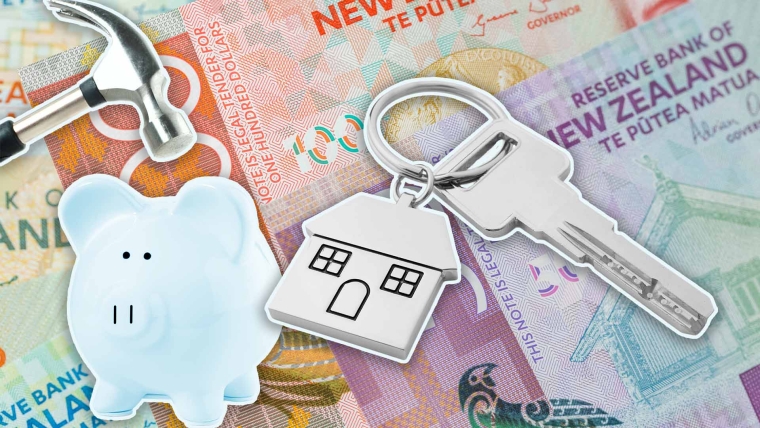
People are continuing to make early KiwiSaver withdrawals - with July hitting a new monthly record high with members taking out more than $234.8 million.
In July, KiwiSaver members made 9390 withdrawals totalling $234,851,774. The withdrawals were made by people buying their first homes and/or those experiencing financial hardship. KiwiSaver members can withdraw funds under both categories within the same period.
This data comes from the Inland Revenue Department (IRD) which tracks monthly KiwiSaver statistics.
About 4950 withdrawals were made because of financial hardship, totalling $43,217,984, according to IRD data. There were 4440 withdrawals for first homes totalling $191,633,790.
For the number of KiwiSaver fund withdrawals, IRD rounds up to the nearest 10.
July’s figures are higher than in previous months, surpassing May which initially held the title of monthly record high with a total of $234,192,710 in withdrawals.
June saw withdrawals totalling $191,811,884 while March was over $225 million.
People usually withdraw money from their KiwiSaver when they reach 65, which is retirement age, but you can also apply for early withdrawals to buy your first house or because of financial hardship.
In July, there were 84,495 savings suspensions - this is when people temporarily stop their contributions. Of those, 1084 stopped their contributions due to financial hardship.
As of July, 798,133 members had their accounts closed or chose to opt out of KiwiSaver. Of this, 610,397 members had closed their accounts while 187,736 chose to opt out.
Members usually have their accounts closed because of death, permanently leaving the country, retirement, serious illness or other reasons.
When it came to KiwiSaver fund types, 649,056 people were in default allocated schemes, 210,327 were in employer nominated schemes and 2,540,230 had actively chosen their schemes in July.
At 739,563 the 25 to 34 age demographic had the largest number of KiwiSaver members. The 35 to 44 age category follows with 739,401 members.
July was also the month when 3702 people became active or provisional (you have eight weeks before you can choose to opt out) KiwiSaver members. There are a total of 3,409,108 active or provisional KiwiSaver members, IRD data shows.
KiwiSaver rules
Following this year’s Budget, changes were made to KiwiSaver.
People aged 16 and 17 are now eligible for KiwiSaver so they can access employer and government contributions.
The Government’s contribution rate has gone down to 25 cents for each dollar a member contributes. This was previously 50 cents for each dollar, which meant receiving a maximum government contribution of $521.43.
To get the Government’s full contribution now, which is $260.72, people need to put in at least $1042.86 of their own money between July 1 to June 30 each year.
Alongside this, people with an income of more than $180,000 will no longer receive the government contribution.
Employer and employee contribution rates will increase to 3.5% from April 2026. This will move to 4% in April 2028.
It’s currently at 3% - KiwiSaver members can choose to stay at the current 3% rate and still be matched at this rate by their employer.
In the spotlight
KiwiSaver has been a hot topic with the Retirement Commission and digital accounting service Hnry looking at the growing disparity between self-employed New Zealanders and salaried wage earners.
Retirement Commissioner Jane Wrightson says “self-employed New Zealanders make up a growing share of our workforce, yet they are being left behind when it comes to retirement savings”.
“Without meaningful reform, we risk seeing hundreds of thousands of people reach retirement without sufficient financial security.
“More retirees will rely heavily on government transfers (such as NZ Super and other benefits) and other public support,” Wrightson says.
“Today’s inaction could become tomorrow’s fiscal burden.”
Alongside this, ANZ Investments managing director Fiona Mackenzie says the country is at a pivotal moment in shaping our retirement savings system.
ANZ is the country’s largest KiwiSaver provider and data from its latest KiwiSaver insights report found that Gen Alpha and Gen Z are contributing to KiwiSaver at “encouraging” rates which “signals a shift toward stronger long-term savings”.
Mackenzie says with the right support Gen Alpha (born from 2013 onwards) and Gen Z (born 1997-2012) could lead New Zealand into a future “where retirement is secure, equitable and sustainable”.
“If we hope to achieve this, we need a shared commitment to addressing the long-term sustainability of NZ Superannuation and KiwiSaver through adjustments to both systems.
“This should include a serious look at gradually increasing both the KiwiSaver default contribution rate and the retirement age, more incentives or assistance for those who find it hardest to save and improved financial literacy initiatives for everyone.”
Increased employer and employee contribution rates and extending government contribution and employer matching to working 16 and 17-year olds were welcomed developments, Mackenzie says.
“At the same time, changes to government contributions may reduce some of the incentives for participation.”
“Ensuring long-term equity across the system remains an important consideration as these reforms evolve,” Mackenzie says.

We welcome your comments below. If you are not already registered, please register to comment.
Remember we welcome robust, respectful and insightful debate. We don't welcome abusive or defamatory comments and will de-register those repeatedly making such comments. Our current comment policy is here.